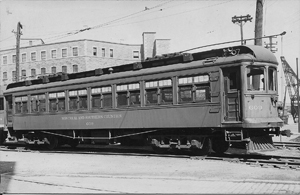Montreal and Southern Counties Railway Reporting mark: CN
The Montreal and Southern Counties Railway (M&SCRC) was an interurban electric line, built by the Grand Trunk Railway (GTR). It operated from 1909 to 1956.

Photo: Phil Bonnet
Construction of the suburban division began in 1906 with the railway being opened in stages as each section was completed. The first section from Montreal to St. Lambert opened in 1909 and was extended to Longueuil in 1910. It was followed by construction of an interurban division that extended to Mackayville (now known as Laflèche) in 1912 with further extensions to Richelieu, Marieville, Saint-Césaire, Saint-Paul-d'Abbotsford, finally ending in Granby in 1916.
Residents in small suburban communities, such as Greenfield Park, were thrilled with the new railway. Not only did it cut their commute time, but came with the added benefit of improved electrical service throughout the entire community.
Upon completion, the railway covered a distance of just over 47 miles and carried both freight and passengers. There were four stations on the Montreal-Longueuil Line and 36 on the Montreal-Granby Line.
With the collapse of the GTR in 1923, Canadian National (CN) assumed ownership of M&SCRC. Since CN had acquired several other interurban lines in the process, it formed a subsidiary called Canadian National Electric Railways as an administrative arm to manage its electric railways. Each of the railways retained its own name and reporting mark and was operated as a separate entity.
In addition to passenger service, the railway also carried freight which was handled out of the Southwark yards. Steam and later diesel were both used on the interurban division, outside of the urban areas.
The Montreal and Southern Counties Railway continued to thrive during the war years, particularly when gas rationing was in effect. In fact it enjoyed its best year ever in 1947. Within a few short years, all that would end.
The boom years of the 1950s launched an unprecedented love affair with the automobile. That, coupled with improved roads and new super highways, led to an almost immediate decline in rail travel. Governments at all levels jumped on the bandwagon actively discouraging anything to do with rail or "streetcars," which were scorned upon as being outmoded and "ancient history." At the end of World War I, 48 cities in Canada were operating electric street railways. Today only one survives.
Officials in the suburban town of Greenfield Park were informed as early as 1952 that their rail tracks would be lifted. The Montreal and Southern Counties Railway in fact lasted until 1956 when service finally ended. By 1964 all of CN's electric railways had been completely shut down or dieselized.
Today a number of factors have contributed to a renewed interest in electric rail. These include the high cost of fuel, major traffic congestion and urban sprawl resulting in huge amounts of time, not to mention frustration, being wasted in the sheer act of commuting. New light rail systems are now operating in Edmonton, Calgary and Vancouver. It now appears quite conceivable that we'll see of a revival of the electric rail service which served Canadian cities so well during the early years of the 20th century.
